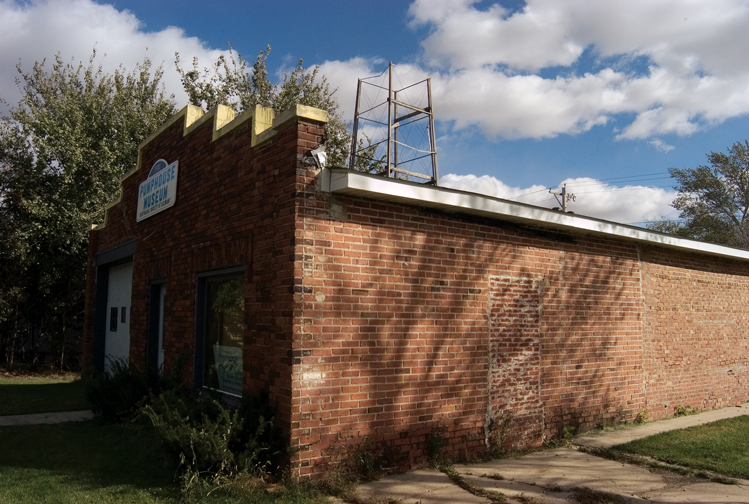The Gift of South Dakota
Subscriptions to South Dakota Magazine make great gifts!
Subscribe today — 1 year (6 issues) is just $29!
The Dark Tower
 |
| The remains of Delmont's Cold War-era watch tower stood on Main Street long after the threat had passed. |
When school ended in Delmont that May, we made so much noise tearing down the stairs that Mr. Raymus, the superintendent, gave us his legendary scowl. It didn’t concern my buddies because they wouldn’t face him again until September, but I worried because he had a fine eye for ringleaders like me. He belonged to my father’s church and he had already passed on more than one comment to the Reverend. Summer, however, meant we could put school aside for a while.
Each morning we got on our bikes with the other boys, heading out in a long line, swinging back and forth on the streets like the tail of a kite. One of us would take the lead and we all got into line, heading past the newspaper office where Mr. Goehring was at the linotype, past Misterek’s Hardware and Appliance, Judge Sharpe’s law office, the Delmont State Bank and Matt Loos’ Grocery, and then we swept into the neighborhoods and past Mr. Frasch’s home to see if the apples were coming on yet. Then we rode out into the county past cornfields and creeks and fluffy cottonwood trees, resting awhile in one of the pastures and sat under shade trees, chewing on grass and talking. Later we went to Ray Devine’s drugstore for fudge bars and popsicles, or comic books at 10 cents apiece.
There was always something to do. Somewhere men would be building or remodeling or shingling a house, or digging ditches for a new water line, or putting in a septic tank, and we would stop and squat and watch them. Then one summer morning, not long after the Korean War began, we saw them building the tower.
We came back into town on our bikes that morning and were heading for the drugstore when we noticed all these men, and pickups and tools, and big beams and planks piled on the lawn by the firehouse. Some of the men were wearing American Legion hats. They were placing the beams into postholes filled with fresh concrete, just a few feet from the city jail. Mr. Rolck, the postmaster, was there, and I asked him what was going on. “Well, boys, we’re building a tower here, and we’ll have a cabin on top,” he said. “Here in South Dakota we’re on the flyways of more than geese. If the Rooskies ever come over on their way to Omaha and the Strategic Air Command, we’ll spot ’em and get on the phone.”
The whole town watched the tower go up, day by day. The men kept up a fierce pace, the tower rising section by section. After a week they began to build stairs to the cabin, and then the cabin was finished on top. The tower was at least 70 feet high, the tallest thing in Delmont except for the grain elevators and the steeple on our father’s church.
When we biked by each day we saw a man up in the cabin, silhouetted against the sky, watching with binoculars. The men took shifts for several weeks, but then one afternoon no one was up there; the cabin was empty. Why weren’t they keeping watch?
In the days to follow the cabin was frequently empty, until finally no one was watching. We talked about this a lot. We also asked ourselves why the men had never been up in the tower at night. Wouldn’t the Russians come over in the night? If our men had been up there at night, could they have heard anything?
We had seen pictures in schoolbooks and in Life magazine of the mushroom clouds over Hiroshima and Nagasaki. Why was no one watching the flyway?
It was time for a commando raid on the tower to see for ourselves what had gone wrong. We could handle a raid on the tower because of our war games down at Perman’s Creek, a lovely, cool place south of Delmont with tall cottonwoods and grasses. One day we would fight the Japanese, another day the Germans, and then the North Koreans. We were armed with every weapon the GIs had except tanks, and suffered many wounds and fatalities, but we were always brave, and we always won.
Jim and I and my best friend, Gerald, were chosen to raid the tower. We sneaked up to it one night, as it was getting dark. We thought we might be seen going up the stairs, even crouched over and quiet as we were, because people were still walking home from shopping uptown. But not one looked up to see us against the twilight. My brother was the biggest and strongest so he began to push up on the trap door of the cabin, and soon we were inside. When we were sure no one had seen us, we shined our Scout flashlights on the walls and ceiling.
There they were, on posters, the black silhouettes of Russian fighter planes and bombers, named and numbered. I reached for the phone and lifted the receiver. It was dead, disconnected. We looked out the tower windows at the treetops below us, soft and bushy, glowing in the lights of Main Street. We saw things as we had never seen them before. Then we sat down in silence, waiting for Main Street to empty out before we left the tower, barely seeing the others’ outlines in the darkness. We knew what the Russian planes carried in their swollen bellies.
Editor’s Note: Author Jeremy Wild taught English and English composition for many years at Emporia State University in Emporia, Kansas. This story is revised from the January/February 2007 issue of South Dakota Magazine. To order a copy or to subscribe, call (800) 456-5117.




Comments